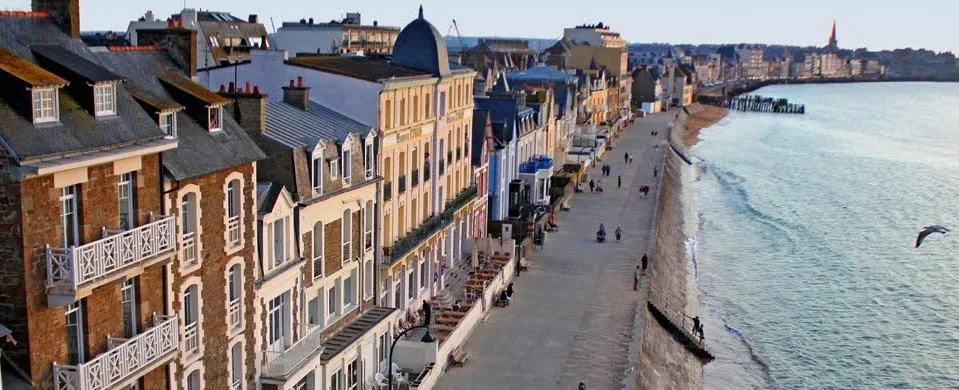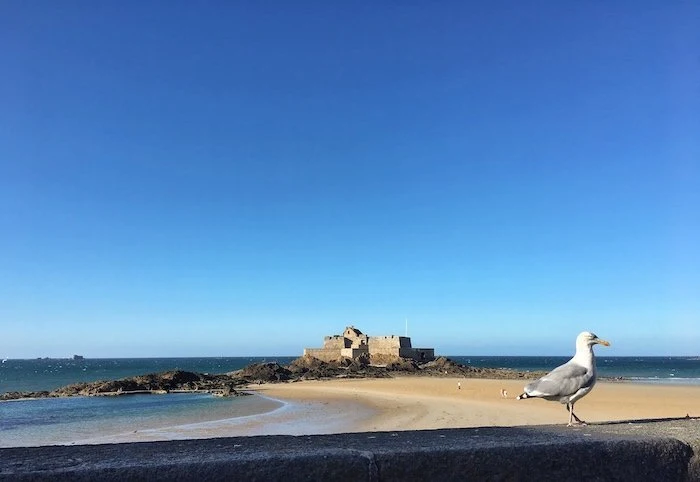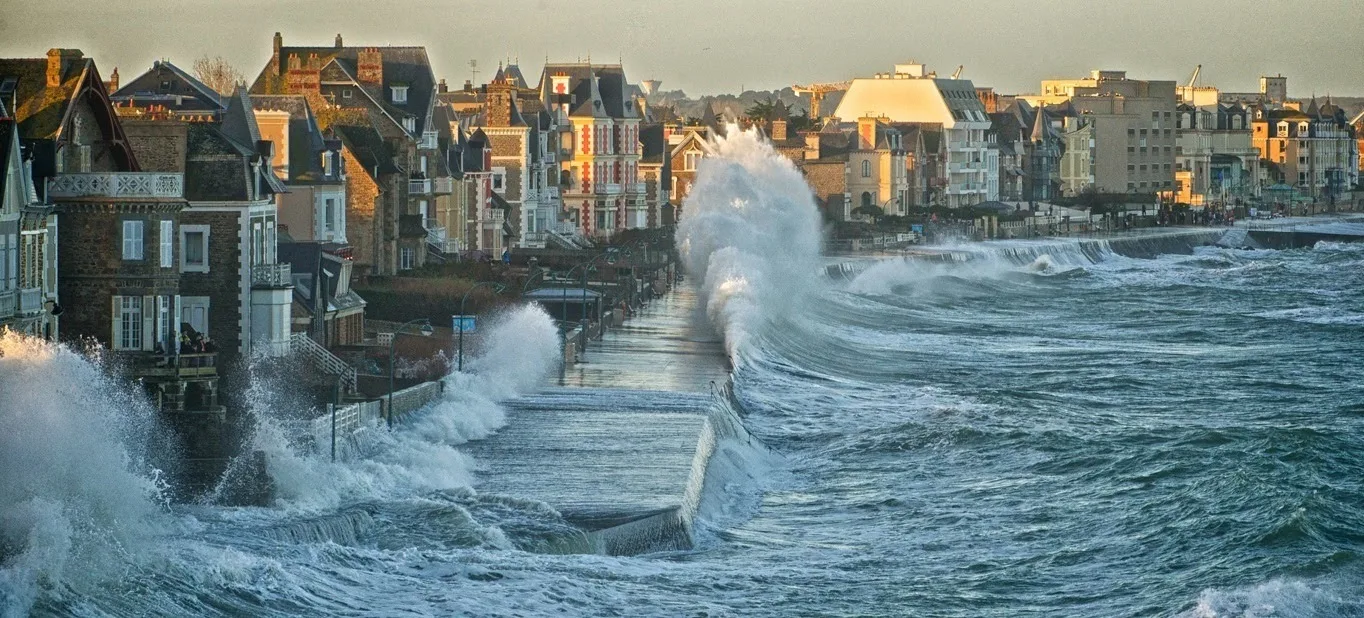Saint-Malo is a port city in Brittany, France, on the banks of the English Channel. Once a fortified pirate base, Saint-Malo was later fortified from attacks by the Normans and the British. Now it is one of the main tourist centers in Brittany. In summer, due to tourists, the city's population increases from the usual 50 to 200 thousand people.
 |
| Saint-Malo Brittany France |
The main attraction of Saint-Malo is the fortress, preserved on the seashore - Les remparts de Saint-Malo. The fortified city center, bounded by ramparts (intramuros), was badly damaged during World War II, but has been painstakingly rebuilt.
In early July, the Festival des Folklores du Monde is held here, a folklore festival, when the city is filled with musical and dance performances. Every four years the city of Saint-Malo is the starting point of the famous solo transatlantic yacht race Route du Rhum to Pointe-a-Pitre in Guadeloupe.
Guide to Saint-Malo
A city of corsairs overlooking the sea, Saint-Malo is today a famous seaside resort. The walled city of Saint-Malo has been magnificently restored to its original style after 80% of it was destroyed in August 1944. The city forms a magnificent whole with its ramparts, castles and beautiful buildings. Be sure to walk along the ramparts for stunning views of the sea, the sandy beaches below, the National Fort (built by Vauban), the port and buildings inside the fortified city.
 |
| Saint-Malo Brittany France |
To learn more about the history of Saint-Malo, you can go to the large citadel of the castle, which houses the Museum of the History of the City and the Countryside of Malouin. You can also visit the Great Aquarium, completely dedicated to the marine world.
To get to Saint-Malo
The city occupies a privileged position in Brittany (France. Saint-Malo, located at the northern tip of Ile-et-Vilaine, on the outskirts of Normandy and near Mont Saint-Michel, is also a foothold for the Channel Islands and England.
By car:
- how to get to Saint-Malo by car (distance, travel time, cost of toll roads, parking).
- from Paris highway A11, then RN 137.
- from Normandy - highway A84.
By plane:
- the nearest airport is Dinard-Pleurtuit-St-Malo Airport, 13 km away (Ryanair).
- From the airport only by taxi (€ 22 to the station, € 25 to the center), societies. there is no transport from the airport.
By train: Saint-Malo train station - further 1 km south from the center, 20 minutes on foot.
- How to get to Saint-Malo by train: schedule, cost.
- 3 direct trains to Paris (Gare de Montparnasse station, approx. 3 hours on the way, € 50),
- hourly trains from Rennes (50 min en route, € 15).
By bus: cheaper, but slower than trains.
- Buses to Saint-Malo: timetables, routes, prices
- 2 buses / day to Pontorson (route 17, 1 hour on the way, € 2.5), departure from the station, stop at the old town.
- Direct buses to Mont Saint Michel (€ 22).
- Buses to Dinard (direction Rennes, € 4.70), Titeniac (direction to Illenoo, € 6.80).
By Ferry: There are several ferries from the UK to Saint Malo:
- From the ports of Poole and Weymouth, Condor Ferries.
- From Portsmouth - Brittany Ferries.
- From Jersey & Guernsey - Condor Ferries.
In the city:
- the historical center - the fortress of Saint-Malo - is easier to see on foot, you can take a tourist mini-train (€ 5.50).
- to the center - you can take a bus (€ 1.5), there are no buses in the evening.
- from the Park & Ride parking - free shuttle (every 15 minutes, in high season)
- Transport scheme for the city of Saint-Malo
History of Saint-Malo
Founded by the Gauls in the 1st century BC, the ancient city on the site of Saint-Malo was known as the Roman Reginca or Aletum. By the end of the 4th century AD, the area of Saint-Servan was the site of a large fort on the promontory of the Saxon Coast, which protected the mouth of the Rance River from sea raids from abroad. According to Notitia Dignitatum, the fort was garrisoned by militum Martensium under the command of the dux (commander) Tractus Armoricanus.
 |
| Saint-Malo Brittany France |
During the decline of the Western Roman Empire, Armorica (modern-day Brittany) rebelled against Roman rule under the rule of Bagaud and in the 5th and 6th centuries took in many Celtic Britons who fled from instability across the English Channel. Modern Saint-Malo dates back to a monastic settlement founded by Saints Aaron and Saint Brendan in the early sixth century. Its name comes from a man who is said to have been a follower of Brendan the Navigator, Saint-Malo or Macloux, an immigrant from what is now Wales.
 |
| Saint-Malo Brittany France |
The city had a tradition of asserting its autonomy in relations with the French authorities and even with the local Breton authorities. From 1590 to 1593 Saint-Malo proclaimed itself an independent republic, taking the motto "not French, not Breton, but Malouin".
Saint-Malo became known as the home of corsairs, French privateers, and sometimes pirates. The corsairs of Saint-Malo not only forced English ships crossing the English Channel to pay tribute, but also brought wealth from distant countries. Jacques Cartier lived and sailed from Saint-Malo to the Saint Lawrence River, visiting the villages of Stadacona and Hohelaga, which would later become the current cities of Quebec and Montreal, respectively. Cartier is considered the first European to visit these places and learned the local word "kanata" (meaning a group of houses), becoming the discoverer of Canada.
